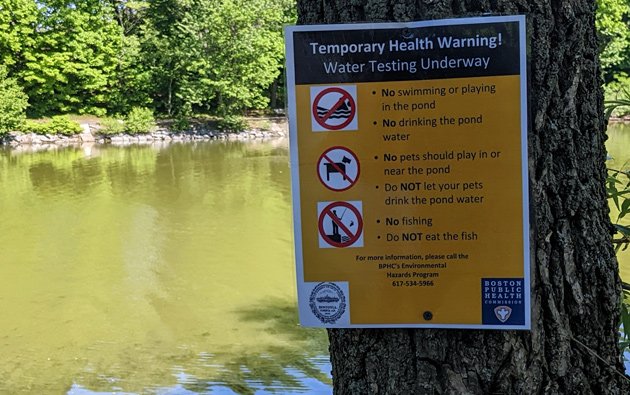Jamaica Pond became toxic early this year; closed to boating, fishing and dogs

Only some of that green is due to reflections off the trees.
The Boston Public Health Commission announced yesterday that a bloom of toxic blue-green algae means Jamaica Pond's water is no longer safe to go in or fish in.
These blooms may produce toxins that can make people and pets sick. Park visitors are urged to avoid contact with the water and any areas of algae concentration, even on shore.
That means no boating or fishing. Dog owners and parents should make sure to keep their pets and children out of the water - and wash them down should they get in anyway.
Pond regulars began noticing the pond's normally clear water turning a sickly shade of green several weeks ago. Last year's bloom of the microorganism, also known as cyanobacteria, didn't start until mid-July. It didn't dissipate until September.
The commission adds:
Contact may cause skin and eye irritation, and inhalation can cause respiratory irritation and exacerbate pre-existing respiratory conditions. Toxins are not absorbed through the skin. Ingestion of blue-green algae can cause acute gastrointestinal symptoms, such as vomiting and diarrhea. If the blue-green algae are producing toxin(s), the health effects can be more serious, especially for small pets due to their smaller body weights. Ingestion of the toxins can cause acute gastrointestinal distress and, depending on the specific toxin, can affect the functioning of the liver, kidneys, and/or neurological systems and in severe cases can result in death.
Call your veterinarian immediately if your dog has been around an algae bloom and shows symptoms such as vomiting, staggering, drooling, or convulsions. These symptoms present themselves soon after exposure. Dogs have been known to eat the scum that washes ashore and/or lick scum out of their fur.
Ad:

Comments
are any steps being taken to review use of fertilizer nearby?
I would hope the people in charge of the Pinebank field (MDC, Boston Parks?) use limited amounts of fertilizer for that space. Similarly, I wonder what's going on uphill at places like the Hellenic College, Larz Anderson park, etc...
The majority of Larz Anderson
The majority of Larz Anderson and Helennic don't drain to the pond (a lot of that run off goes into culverts and doesn't become surface water) although some of those lands do. Perhaps a bigger source of run off would be the enormous estates between Lee, Goddard, Warren, and Walnut. All of which drain to a lovely little brook you can see from Cottage Street, and also Sargent Pond, both of which drain directly into Jamaica Pond. There even looks like someone is doing a little "gentleman farming" in that area, too.
I wonder what the cyanobacteria count (or at least, the free nitrogen count) is like in Sargent Pond.
Thanks
That is interesting info.
Road salt run off
These particular toxic blooms are largely caused by road runoff - primarily from salt and particles from car exhaust. The past several years Boston and DCR have been laying down ridiculous amounts of salt in the winter.
The only real solution is to do hard pack and sand in the winter and to limit internal combustion engine vehicular traffic around the parkways year round.
Imagine how much safer and
Imagine how much safer and more pleasant the pond would be with no cars driving mere feet away. The DCR closed one street on weekends two years ago but stopped unfortunately.
Nitrogen, phosphorus, sure.
Nitrogen, phosphorus, sure. Can you cite anything that links salt or soot (which modern cars make almost none) to increased algae growth?
There has been ridiculous amounts of salt the past 2 years
It looks like it does play into it because the sodium attaches to soil particles and displaces phosphorus, also causing excess runoff due to soil compaction and less drainage.
https://plant-pest-advisory.rutgers.edu/impact-of-road-salt-on-adjacent-...
Other times phosphorus is added to the salt compound.
https://www.solitudelakemanagement.com/blog/winter-road-salt-and-aquatic...
https://www.pca.state.mn.us/sites/default/files/pstudy-appendix-f.pdf
https://www.nacdnet.org/2017/02/06/tis-season-road-salt-applications-cat...
“up to 63 percent road salt is transported by air into the surrounding environment.”
They have been putting down so much lately that you really can see it floating around in the area creating a haze or mist. There’s nothing green about it.
In my HP neighborhood, when
In my HP neighborhood, when chickens are not crossing the road, there were still little hills of salt in the middle of the street, months after the winter storms.
That sign is way too vague.
That sign is way too vague. From reading it, you wouldn't know there's a suspected water quality problem. The sign needs to have a date written on it too.
Dog waste is a big problem for local waterways
Dog and goose waste is a huge problem for water quality in the Charles and places like Jamaica Pond.
https://www.boston.gov/sites/default/files/file/2020/05/water%20%26%20se...
Not as much as all the runoff from cars, but seeing how little interest the state has in creating a larger buffer near waterways by reducing lanes that seems less likely than forcing dog owners to clean up.